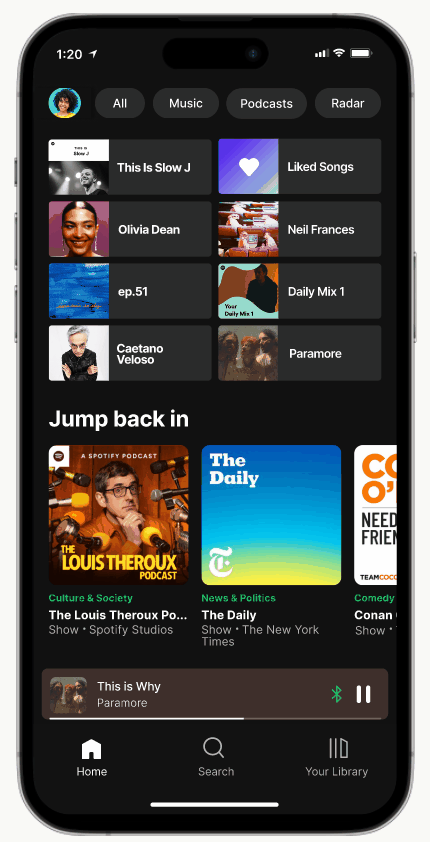
Radar - Find out what your neighborhood sounds like
Overview
Year: 2024
Role: Ux Researcher & Ui Designer
Personal Project
The Idea
Inspired by the feeling of being musically 'stuck,' this feature leverages our curiosity, offering fresh opportunities to explore music beyond the algorithm.
The Goal
Add a feature to Spotify that enables users to explore new tracks, artists, and genres by tuning into what people around them are listening to, providing a human-driven alternative to algorithmic recommendations for discovering music.
Research




Research Goals:
-
Understand users' comfort levels with sharing music outside their social circles.
-
Identify the motivations for using the Radar feature and how users would prefer to engage with it.
-
Identify privacy concerns and think about solution on how users could have control over how their music is shared.
I started my research by conducting a survey to explore users’ comfort levels with sharing their music beyond their friend groups. Through this survey, I gathered insights on how, when, and why users would engage with this feature, both publicly and privately. A significant focus was placed on understanding the privacy concerns of users - and many respondents expressed a strong desire for control over their music-sharing preferences.
This part of the research laid the foundation for me to design a feature that allows a freely music discovery and sharing but also allowing the user to have options over their own profile privacy.
Persona Development
Based on the responses from my survey and insights gathered from online research about Spotify’s algorithms and the concept of sharing music, I identified several distinct personas and potential users for the Radar feature.
These personas reflect varying attitudes toward music discovery and sharing, highlighting different preferences for privacy, social interaction, and the desire for new ways to connect through music.




Findings
1/ Interest
The feature has been generally well-received, sparking excitement about sharing music with nearby listeners.
As shown in the personas, the feature offers diverse use cases, including commuting, traveling in another country, exploring a neighborhood, and how independent music creators could also use it in their favor. Additionally, in face-to-face discussions with survey participants, they often shared even more ideas and suggestions, highlighting the feature's potential.
2/ Privacy Preferences
Users strongly favor anonymous sharing, I think this specially applies on a first use - but from the start was obvious that the design needed to incorporate options to ensure privacy. Privacy controls should allow users to control visibility, such as sharing only song or artist information without exposing personal details.
3/ Context and Usage Scenarios
Considering all the usage scenarios emphasizes the need for a seamless, easy-to-use experience in active settings that blends well with the already existing spotify design.
The most important take away from usage scenarios is to highlight the feature as music discovery and not as another social feature.
Design









I aimed to incorporate design elements that already work well in Spotify, to ensure familiarity and ease of use.
While I could have developed this feature as a standalone app, adding another app to connect with a music app felt inconvenient from a user perspective.
Instead, I focused on integrating seamlessly within Spotify’s design language, carefully adapting existing elements and adding new ones to enhance the user experience.
This approach allowed me to pay attention to subtle details, making it both a fun and insightful process to design an extension of Spotify that feels intuitive and natural to its users.
Iteration Note
This is an MVP, so there’s still plenty of room for enhancement as I continue testing and gathering feedback. The diverse personas created from my research have been invaluable, allowing me to consider the needs of different age groups and ensure that users immediately understand the feature’s purpose. Most users find it intuitive, exciting, and are quick to offer new ideas. The core focus remains on music discovery rather than social interaction, aligning with the goal of making Radar a unique way to explore new music nearby.